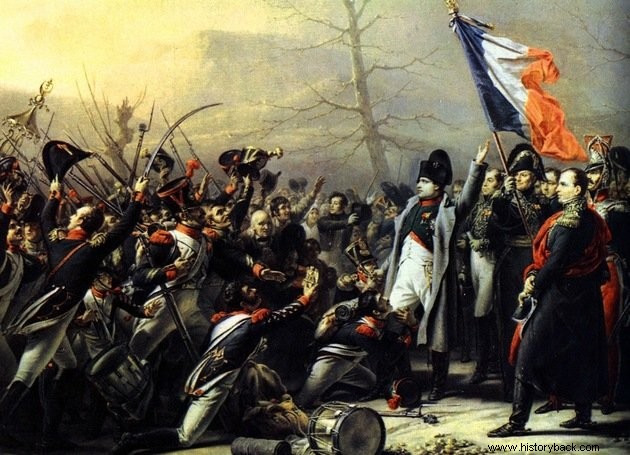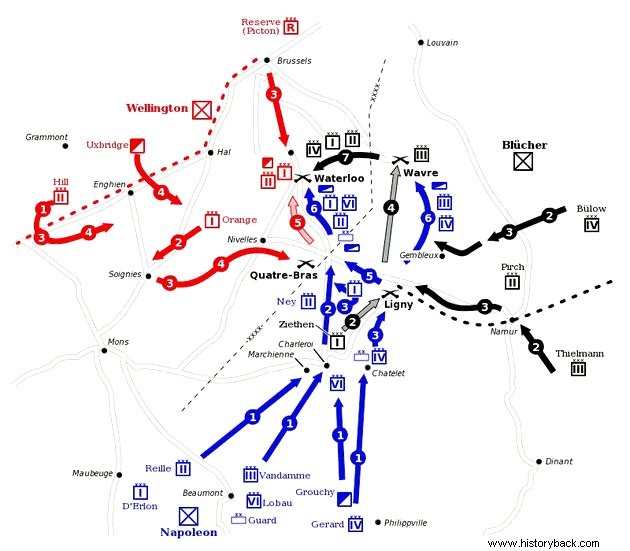The Battle of Waterloo marked the end of the Napoleonic Era (1799-1815).
The fight lasted only one day, on June 18, 1815. French, English and their allies faced each other on the battlefield that ended in French defeat.
After the conflict, Napoleon Bonaparte was arrested by the British and taken to the island of Elba, while the victors gathered around the Congress of Vienna to redraw the European map.
Background of the Battle of Waterloo
After ruling France for 15 years, Napoleon Bonaparte is defeated and forced to abdicate. He is imprisoned with his closest associates on the island of Elba, off the Italian coast. King Louis XVIII – brother of the guillotined Louis XVI – ascends the throne of France supported by monarchists.
However, the general's rest ends early, as he soon manages to escape the island of Elba and marches on Paris on March 1, 1815. To avoid a civil war, King Louis XVIII takes refuge in the Dutch city of Ghent.
Meanwhile, the European powers, England, Prussia, Austria, condemn Napoleon's attitude and relaunch the war against the Emperor.
 See also:France
See also:France Hundred Days Government
Napoleon becomes obsessed with trying to regain his former dominions. For this he has two clear objectives:to gather a new army and attack the English troops stationed in the town of Waterloo (present-day Belgium). This period is called the Hundred Days' Government.
Marching towards Waterloo, Napoleon Bonaparte achieves two victories. The first at Ligny, where he defeated the Prussians. Then in Quatre Bras, where the French general Michel Ney manages to partially defeat England on June 16.
At Waterloo, he would face his great adversary, the English Duke of Wellington (1769-1852).
The Battle – June 18, 1815
Returning to his usual tactics, Napoleon hoped to defeat the Allied armies before engaging the bulk of the British troops.
However, this time, nothing seemed to go right for the French general. His troops were tired and the day before the battle it had rained heavily, which made it difficult for weapons and soldiers to move over the terrain.
Likewise, his state of health was not the best. Sick and tired, he could not convey his enthusiasm to his men. With the mud, the cannonballs didn't bounce off the battlefield and didn't reach the British.
Despite this, he took the initiative to attack throughout the day. The British receive support from the Prussian army at 19:00 and at 21:30, the Prussian and English commanders celebrated their victory. It was the end of the Napoleonic Era.
On the map below we can see the moment when the French troops (dark blue) are surrounded by the British and allies (red) and the Prussian army (black).

Consequences of the Battle of Waterloo
Napoleon's defeat marks the end of the Napoleonic Empire and French hegemony on the European continent. Bonaparte went to prison on the island of Saint Helena, an English possession in the South Atlantic, and died there in 1821.
The Austrian Empire, the Russian Empire and the Kingdom of Prussia unite to form the Holy Alliance and prevent the advance of liberalism on the European continent.
The map of Europe would be redrawn at the Congress of Vienna held in 1815.
Louis XVIII returns to France, restores the Bourbons to the French throne, and reigns until his death in 1824.
As for the United Kingdom, it begins to expand its colonial empire across Africa and Asia. The British would not fight again on European soil until a hundred years later, during the First World War.
See also:Congress of Vienna (1814-1815)